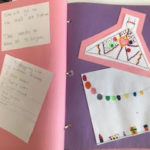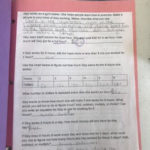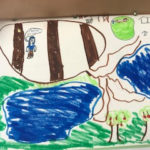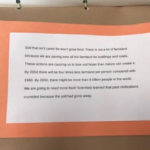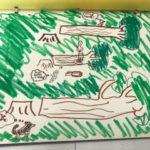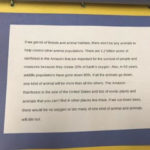Mason
5/28/19
Activism in Photography
Introduction
Photojournalism has been used throughout history to spread the news, but I want to shed new light on what it has to offer. A photojournalist isn’t just a photographer, a photojournalist is also an activist. In my opinion, photojournalism is in fact, one of the most important forms of activism there is. Photos have the power to change people’s minds and wake people up to things they aren’t aware of or are ignoring. They can make people feel a certain way, or just care a whole lot more depending on what they are used for. Photography is a really important tool. What is a photojournalist? According to the dictionary a photojournalist “a journalist who communicates news with photographs.” In my opinion, anyone can be a photojournalist if they want to.
Photography in History
Photography has no doubt played a major role in history. We have seen how photographs have the power to influence people like no other kind media. In addition, with photographs, people are able to see places that they have never seen whereas sometimes it’s hard to picture a place you’ve never been from just words. Photographers who were brave enough to document hard truths have woken people up. Photographs have so much power. In the past photojournalists and just regular people have made history by pressing a button. From exposing the injustices that the civil rights movement was trying to change to showing people the horrible things that were going on during the Vietnam war, pictures have been used to affect change. Many people read magazines like LIFE. In fact, at one point it was selling “13.5 million copies a week”(The New York Times “Race, Civil Rights and Photography” New York Times). This means that millions of people were seeing these photos. Charles Moore, a photojournalist who covered the civil rights movement once said; “my camera is my tool, and I would rather have that be my weapon than my fists any day.” I think that this quote sums up what photojournalism means. I agree with Charles Moore because I believe that a picture can change peoples minds and wake them up to the truth more than anything else.
Photography Today
I believe that the most important invention in the history of photojournalism is the digital camera. Now, you might be thinking “of course,” or “that’s so obvious!” but I have some reasons that you might not have thought of. I believe that the digital camera represents a turning point in the history of photography.
One reason that digital cameras are so important to photojournalism is that you can take many more pictures in a much shorter time. This allows photographers to shoot more shots, which makes the chances of getting a great shot much higher. Also, shots on digital cameras don’t take time to develop which means that photographs can get published for the public to see much quicker than photos taken on film. My last reason why digital cameras are important to photojournalism is that, while cameras are becoming capable of higher quality images, people are able to relate to them more. When I look at an image taken by a digital camera next to an image taken by a film camera, I am more connected to the image taken by the digital camera. This is because higher quality images seem more real, and therefore are easier to connect to. I think that many people experience this phenomenon.
Now with more advanced cameras photographers are able to capture scenes with better and better quality. I believe that photojournalism contributes so much to how we receive information. As our technology is becoming more and more advanced photography is becoming an increasingly helpful tool.
The role of photography today is a little different than the role of photojournalism in the past. One main difference is that anyone can be a photojournalist. Now that so many people have a camera whether it be a smartphone or a higher quality camera, anyone can document what’s going on in the world right now. Also, with social media campaigns like Instagram, Twitter, Facebook, and Youtube seeing literally billions of users worldwide. Your picture could spread around the web in mere hours, educating hundreds of thousands of people. Anyone who wants to change the world can start with photography.
Maybe because photojournalism is so powerful, we’re seeing people want to restrict the freedom of the press. I think that if the press didn’t have as much freedom as it has now, we would run into a lot of problems. To understand the importance of the freedom of the press, you have to understand the role of the press in society today. We rely on the press to give us the news, and to tell us everything that’s going on. If the press didn’t have the right to cover everything, it would defeat the whole point of having it in the first place. Also, restricting the freedom of the press would create a lot of loopholes for people in power to take advantage of. For instance, it might become easier for people in power to cover up and hide what is going on by restricting press coverage. Allowing freedom of the press is one of the best things about our society. It is important that people know what is happening in the world so they can make decisions based on their knowledge. Also, a lot of people will get angry if the freedom of the press is restricted. Humans inherently like to be informed, and the press plays a big role in that.
So I guess what can be taken away by this is that pictures have tremendous power and I urge you to use them if you have the opportunity to affect positive change. Today photojournalists are covering an extremely wide variety of stories.
Paul Schutzer
Many U.S. citizens opposed America’s involvement in the Vietnam War. There were huge protests that took place in the U.S. to try to get the government to withdraw U.S. troops from the war. I believe that photographers like Paul Schutzer had a huge influence on U.S. citizens who weren’t aware of what was going on in Vietnam, and even if people did know what was happening, these pictures provided another level of understanding.
Paul Schutzer was born on July 11, 1930, in Brooklyn, New York. Although he died very young at the age of only 36, he helped many people through his photojournalism. When Paul Schutzer was ten years old he found his first camera. He found it in a wastebasket, taped it up, and started taking pictures. After trying other occupations, Paul Schutzer realized that what he wanted to do was be a photojournalist. So, in 1957, Paul Schutzer became the youngest LIFE Magazine photographer. Over the decade during which he took pictures for LIFE magazine, he took covered all different different issues around the world including; “The Berlin Wall, the earthquake in Iran, the Algerian War, Nixon in South America, Kennedy through his campaign onto his funeral, Cuba and Castro, Lebanon, and Vietnam” (“Paul Schutzer | Biography” klotz gallery). Over the course of his career with LIFE magazine, Paul Schutzer photographed for 491 articles. “Schutzer’s daughter Dena explains, ‘He focused on the people in power and the powerless, the people who were responsible for the events and those who were affected by them’” (Alice Gabriner, “The Six-Day War and the LIFE Photographer Killed in Action” Time).

US Corps-man runs with a wounded Vietnamese baby after the child’s mother found herself and her child in a combat zone. -Paul Schutzer

A young US. soldier guards Vietnamese captives. This soldier later died in the war. -Paul Schutzer
Therese Frare
The AIDS crisis was being widely ignored despite it becoming an increasingly big problem for the U.S. and especially the LGBTQ community. Maybe the reason that AIDS wasn’t being talked about or addressed was that it wasn’t affecting the people in power as much as LGBTQ people. When photographers like Therese Frare started documenting people dying of AIDS many people found it much harder to ignore. This image by Therese Frare became famous and probably saved many lives because after
people started to care that elected officials were addressing the issue. To give you some the perspective, in the United States alone “an estimated 692,790 Americans have died of HIV-related illnesses since the start of the epidemic in 1982” (Mark Cichocki “How Many People Have Died of HIV/AIDS?” Very Well Health). This estimate was made by the World Health Organization, and these numbers are as of 2018.
Unlike Paul Schutzer and Charles Moore, Therese Frare wasn’t a professional photographer when she took the picture that made her famous and, more importantly, showed people up to how serious AIDS was. Therese Frare was a grad student at Ohio University and a passionate AIDS activist. She decided to cover AIDS for a school photography project, but she found out that most people living with AIDS were unwilling to be photographed. She ended up finding a new gender fluid, Native American, HIV positive, friend. Peta was living at the Pater Noster House, a hospice for people living with HIV and AIDS. Peta was great friends with another patient at the Pater Noster House: David Kirby. David Curby was a gay activist who had been estranged from his family. When Therese Frare met David Curby he told her that it was fine for her to take pictures of him, as long as they weren’t used for profit. Therese Frare and David Curby became friendly with one another through Therese Frare’s visits to the Pater Noster House. On the day that David Curby died, Therese was visiting Peta. David Curby had called his family earlier and they had welcomed him back into the family. His family was visiting him for the very last time when she was asked by David Curby’s family to take photos of David Curby’s last moments. Therese Frare used this photo to show how serious and sad AIDS is

The famous image of David Kirby who had AIDS in 1990 -Therese Frare
Charles Moore
The civil rights movement was fighting for equal rights for people of color during the 1950s and 1960s. In my opinion, was greatly helped by photographers like Charles Moore. These photographers weren’t afraid to show the kind of injustice that was occurring in the US. People who were not aware of how badly people of color were being treated were being woken up by photojournalists like Charles Moore.
Charles Moore Lived from 1931 to 2010, and during his life, he took pictures that have affected tons of positive change. A writer for the New York Times once said; “Mr. Moore was probably the most influential of a battalion of still photographers who swept across the South to capture, with compelling clarity, the dramatic collision of massive and passive resistance, black and white, right and wrong” (Hank Klibanoff “What the Still Photo Still Does Best.” The New York Times). He grew up in Alabama. His father was a Baptist minister who talked about racism a fair amount. So Charles Moore grew up caring a fair amount about racism. After spending some time photographing for Montgomery newspapers in Alabama he started photographing for LIFE magazine.
Over the course of his career, he achieved many accomplishments including writing his book, “Powerful Days: The Civil Rights Photography of Charles Moore”, winning the Kodak Crystal Eagle Award from the National Press Photographers Association, and of course, taking some of the most amazing pictures of all time to fight for the rights of people of color. He wasn’t afraid to get close up to the action and he documented many hard truths. His photography revealed the glaring injustices that people of color were facing, and what was going on to stop them. He revealed how the police were responding to the civil rights movement. Over the course of his life, Charles Moore revealed a lot of these injustices and got people to care about what was going on. At one point Charles Moore said, “I don’t wanna fight with my fists, I wanna fight with my camera.” And that is exactly what he did. I believe that Charles Moore’s photos played a major role in ending a lot of the prejudice and racism in America.

The fire department uses fire hoses against civil rights protesters.-Charles Moore

Policemen turn dogs on civil rights protesters -Charles Moore
Conclusion
For anyone who cares about an issue and sees the consequences of it in their life, photojournalism is one of the most effective ways to create change. Almost everyone has seen an image that impacts them emotionally in some way, and makes them care about a certain person, thing, or idea. But when you imagine the kind of person who might take a photo like this, you might think of a professional behind a huge fancy camera. But that is not necessarily how meaningful photos are created, as you have learned in the case of Therese Frare. You could be that photographer. Anyone who has a way to take a picture whether it be a smart phone camera, cheap point and shoot, or DSLR, has the capacity to affect change through photography. Now with social media platforms seeing billions of users, images you post can be more widely viewed in an even shorter amount of time. You don’t have to get your photograph published through a magazine or official publication. In order for someone to see your photography in a publication, typically they need to have a subscription whereas social media is usually free and therefore gives you access to more people from all different backgrounds. Posting your pictures on social media can affect more people. If you care about an issue, but don’t know how to start working to fix it, photojournalism might be an amazing way for you to create change.�
Works Cited
Mark Speltz. “Black Lives Matter: What Role Do Photographs Play?” Time, Time, time.com/4429096/black-lives-matter-civil-rights-photography/.
“Charles Moore.” International Center of Photography, 27 Apr. 2019, www.icp.org/browse/archive/constituents/charles-moore?all/all/all/all/0.
Cichocki, Mark. “How Many People Have Died of HIV/AIDS?” Verywell Health, Verywellhealth, 26 Feb. 2019, www.verywellhealth.com/how-many-people-have-died-of-aids-48721.
“David Kirby (Activist).” Wikipedia, Wikimedia Foundation, 16 Oct. 2018, en.wikipedia.org/wiki/David_Kirby_(activist).
Dunlap, David W. “Charles Moore Dies; Depicted Rights Battles.” The New York Times, The New York Times, 15 Mar. 2010, lens.blogs.nytimes.com/2010/03/15/parting-5/.
Durham, Michael S., and Charles Moore. Powerful Days: The Civil Rights Photography of Charles Moore. University Alabama Press, 2007.
Editors, History.com. “Civil Rights Movement.” History.com, A&E Television Networks, 27 Oct. 2009, www.history.com/topics/black-history/civil-rights-movement.
Gabriner, Alice. “The Six-Day War and the LIFE Photographer Killed in Action.” Time, Time, time.com/4783803/paul-schutzer-six-day-war-remembrance/.
“History of HIV and AIDS Overview.” AVERT, 26 Nov. 2018, www.avert.org/professionals/history-hiv-aids/overview.
Kaplan, and John. “The Life Magazine Civil Rights Photography of Charles Moore 1958-1965.” Journalism History, Journalism History, 1 Jan. 2000, www.questia.com/library/journal/1P3-56322666/the-life-magazine-civil-rights-photography-of-charles.
Klibanoff, Hank. “What the Still Photo Still Does Best.” The New York Times, The New York Times, 20 Mar. 2010, www.nytimes.com/2010/03/21/weekinreview/21klibanoff.html.
“Legendary Civil Rights Photographer Charles Moore, 79.” NPPA, 4 Oct. 2012, nppa.org/news/557.
O’Neill, Claire. “Charles Moore, Photographer Of The Civil Rights Movement, Dies At 79.” NPR, NPR, 16 Mar. 2010, www.npr.org/sections/pictureshow/2010/03/charles_moore.html.
“Paul Schutzer | Biography.” KLOTZGALLERY.COM, www.klotzgallery.com/paul-schutzer-bio.
Ben Cosgrove. “Paul Schutzer: A Great Photographer’s Final Pictures.” Time, Time, time.com/21616/paul-schutzer-a-great-photographers-last-pictures/.
Reeves, Jay. “Charles Moore, Photographer Who Covered Civil Rights Movement, Dies.” DeseretNews.com, Deseret News, 16 Mar. 2010, www.deseretnews.com/article/700016861/Charles-Moore-photographer-who-covered-civil-rights-movement-dies.html.
The New York Times. “Race, Civil Rights and Photography.” The New York Times, The New York Times, 18 Jan. 2016, lens.blogs.nytimes.com/2016/01/18/race-civil-rights-and-photography/.
“The Vietnam War: The Pictures That Moved That Most.” Time, Time, time.com/vietnam-photos/.
“Therese Frare: Gone Too Soon | About the Hero.” Lowell Milken Center, 13 July 2018, www.lowellmilkencenter.org/programs/projects/view/gone-too-soon/hero.



